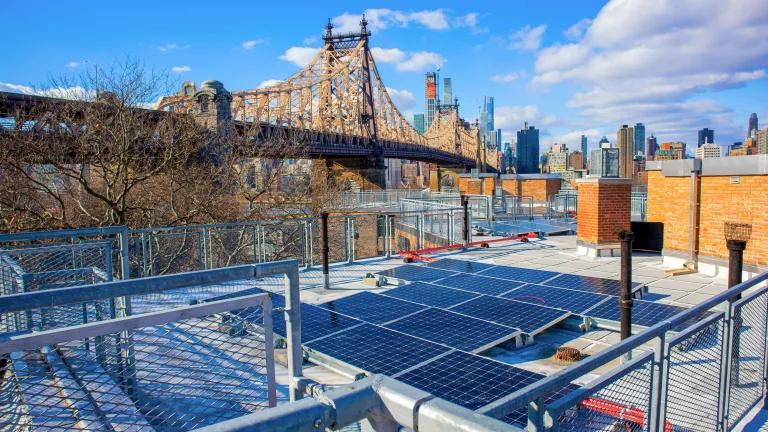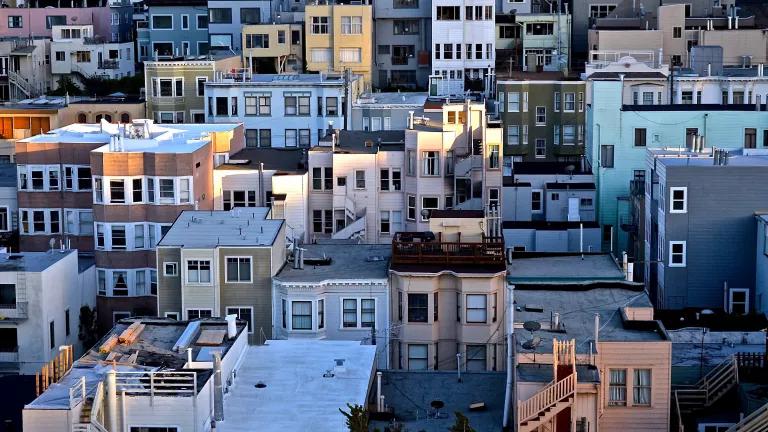New Analysis: Strong NY Efficiency Target Will Save Billions
New Yorkers could save more than $7 billion on their energy bills while avoiding 15 million tons of carbon dioxide pollution within seven years if Gov. Andrew Cuomo sets a strong energy efficiency target for the state, according to a new study released today.

New Yorkers could save more than $7.7 billion on their energy bills while avoiding more than 15 million tons of carbon dioxide pollution within seven years if Gov. Andrew Cuomo sets a strong energy efficiency target for the state, according to a new study released today.
Optimal Energy Inc., a leading energy efficiency consulting firm, released its analysis less than a month before Earth Day, April 22, which Cuomo has set as his deadline to announce a “comprehensive and far-reaching energy efficiency initiative” that will include a 2025 energy efficiency savings goal for the state.
Increasing energy efficiency to the level of other leading states will produce significant benefits for the Empire State, such as improved public health; well-paying, local clean energy jobs; lower energy bills (by more than $7.7 billion based on Optimal’s estimate); and a major decrease of more than 15 million tons of carbon dioxide in climate-warming carbon emissions . New York needs to scale up its energy efficiency efforts to maintain its status as a leader in the fight against climate change through goals such as generating 50 percent of its electricity from renewable sources and reducing economy-wide carbon emissions by 40 percent from 1990 levels by 2030.
NRDC joined over 50 other organizations last month in sending a letter to Cuomo, urging him to set an energy-saving standard across all fuels that would grow clean energy businesses, require a strong utility role, build in diversity and equity, and drive the consumer energy efficiency market. (To learn more, visit the group’s webpage.)
Optimal’s analysis shows that adopting—and effectively implementing—an ambitious energy efficiency framework is entirely feasible. Highlights include:
Electric energy efficiency programs
Optimal’s analysis shows that utilities, which are critical to advancing energy efficiency in the state, can increase their annual target incrementally each year for helping electric customers save energy by more than 300 percent (from current levels of roughly 1 percent annually to just over 3 percent of electric sales) by 2025. Optimal’s analysis shows that it is achievable to reach energy-savings of 3.15 percent.
This level of ambition yields over 26,000 gigawatt-hours (GWh) in total electric sector savings (as summarized in the table below), which is equivalent to the amount of electricity needed to power more than 3.8 million New York homes. These results are consistent with energy savings achieved by utilities in leading states such as Massachusetts and Rhode Island as is discussed further in a 2016 study published by Synapse Energy Economics.
|
Year |
Savings (%) |
Electric Savings (GWh) |
# NY Households Electric Use |
|
2018 |
1.00% |
1,438 |
209,927 |
|
2019 |
1.40% |
2,054 |
299,854 |
|
2020 |
1.80% |
2,632 |
384,234 |
|
2021 |
2.20% |
3,208 |
468,321 |
|
2022 |
2.60% |
3,790 |
553,285 |
|
2023 |
2.87% |
4,170 |
608,759 |
|
2024 |
3.13% |
4,539 |
662,628 |
|
2025 |
3.15% |
4,542 |
663,066 |
|
Cumulative |
|
26,373 |
3,850,073 |
In addition to increasing utility program energy-saving targets, the report recommends that the state strengthen and streamline efficiency programs administered by state agencies such as the New York State Energy Research and Development Authority (NYSERDA), New York Power Authority (NYPA), and Long Island Power Authority (LIPA, which has contracted with PSEG-Long Island to administer energy efficiency programs and operate Long island’s grid).
Gas efficiency programs
In addition to reducing the need to use fossil fuels to generate electricity, a comprehensive energy efficiency initiative and target should reduce the amount of fossil fuels burned onsite to heat buildings and water. One strategy should be to shift to efficient electric technologies, such as heat pumps, that reduce the amount of oil and gas needed for heating and cooling.
Establishing a statewide gas energy-saving target would reduce the total amount of natural gas burned in buildings through the implementation of programs to reduce onsite fossil fuel use. Optimal found that establishing a statewide gas energy-saving target of approximately 1.65 percent (ramping up from the current level of 0.27 percent) is attainable. This translates to a 66,047 BBtu reduction in natural gas demand by 2025, enough to heat more than 1.1 million homes.
Codes and Standards
The state can further reduce energy consumption by implementing stronger building energy codes that require more efficient design and construction practices. Championing ambitious energy efficiency standards for appliances (such as washing machines, lighting, and electronics) will also save customers money while reducing energy consumption.
Optimal estimates that by 2025, improved energy codes and new energy efficiency standards for appliances and equipment could reduce electric consumption by over 8,400 GWh of electricity (enough to power more than 1.23 million New York homes) and gas consumption by approximately 28,215 BBtu (enough to heat more than 480,000 homes).
All Eyes on Earth Day: Governor Cuomo Can Lead on Energy Efficiency
As the Trump administration continues to roll back climate policies, Governor Cuomo has a clear and present opportunity to demonstrate New York’s leadership in clean energy by adopting an energy efficiency framework that is not only nation-leading but, as Optimal’s analysis shows, also quite achievable. If he chooses the strong target of just over 3 percent, New Yorkers will benefit from lower utility bills, more jobs, and cleaner air.




